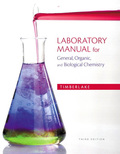
Concept explainers
a.
To determine:
If the given statement “has a sour taste” is the characteristic of an acid or a base.
Introduction:
The chemical compounds or molecules which donate hydrogen ion or proton are known as acid whereas the compounds or molecules which accept the incoming hydrogen ion or proton are known as base. The value of acids on
a.
Answer to Problem 9.1PP
Correct answer:
Having sour taste is the characteristic property of acids.
Explanation of Solution
When acid is dissolved in water or comes in contact with the saliva of the mouth, it releases its proton and stimulates the neural receptors of brain, which gives feeling of tartness. Hence, sour taste is the characteristic of an acid.
b.
To determine:
If the given statement “accepts a proton” is the characteristic of an acid or a base.
Introduction:
The chemical compounds or molecules which donate hydrogen ion or proton are known as acid whereas the compounds or molecules which accept the incoming hydrogen ion or proton are known as base. The value of acids on
b.
Answer to Problem 9.1PP
Correct answer:
Acceptance of proton is the characteristic property of bases.
Explanation of Solution
According to the Bronsted-Lowry theory of acid and base, the substance that release
c.
To determine:
If the given statement “produces H+ ions in water” is the characteristic of an acid or a base.
Introduction:
The chemical compounds or molecules which donate hydrogen ion or proton are known as acid whereas the compounds or molecules which accept the incoming hydrogen ion or proton are known as base. The value of acids on
c.
Answer to Problem 9.1PP
Correct answer:
Production of H+ ions in water is the characteristic property of acids.
Explanation of Solution
According to
d.
To determine:
If the given statement “is named potassium hydroxide” is the characteristic of an acid or a base.
Introduction:
The chemical compounds or molecules which donate hydrogen ion or proton are known as acid whereas the compounds or molecules which accept the incoming hydrogen ion or proton are known as base. The value of acids on
d.
Answer to Problem 9.1PP
Correct answer:
Name ‘Potassium hydroxide’ is a characteristic of base.
Explanation of Solution
The chemical formula of potassium hydroxide is
Want to see more full solutions like this?
Chapter 9 Solutions
EBK LABORATORY MANUAL FOR GENERAL, ORGA
- Please help me Please use https://app.molview.com/ to draw this. I tried, but I couldn't figure out how to do it.arrow_forwardPropose a synthesis of 1-butanamine from the following: (a) a chloroalkane of three carbons (b) a chloroalkane of four carbonsarrow_forwardSelect the stronger base from each pair of compounds. (a) H₂CNH₂ or EtzN (b) CI or NH2 NH2 (c) .Q or EtzN (d) or (e) N or (f) H or Harrow_forward
- 4. Provide a clear arrow-pushing mechanism for each of the following reactions. Do not skip proton transfers, do not combine steps, and make sure your arrows are clear enough to be interpreted without ambiguity. a. 2. 1. LDA 3. H3O+ HOarrow_forwardb. H3C CH3 H3O+ ✓ H OHarrow_forward2. Provide reagents/conditions to accomplish the following syntheses. More than one step is required in some cases. a. CH3arrow_forward
- Identify and provide an explanation that distinguishes a qualitative and quantitative chemical analysis. Provide examples.arrow_forwardIdentify and provide an explanation of the operational principles behind a Atomic Absorption Spectrometer (AAS). List the steps involved.arrow_forwardInstructions: Complete the questions in the space provided. Show all your work 1. You are trying to determine the rate law expression for a reaction that you are completing at 25°C. You measure the initial reaction rate and the starting concentrations of the reactions for 4 trials. BrO³¯ (aq) + 5Br¯ (aq) + 6H* (aq) → 3Br₂ (l) + 3H2O (l) Initial rate Trial [BrO3] [H*] [Br] (mol/L) (mol/L) | (mol/L) (mol/L.s) 1 0.10 0.10 0.10 8.0 2 0.20 0.10 0.10 16 3 0.10 0.20 0.10 16 4 0.10 0.10 0.20 32 a. Based on the above data what is the rate law expression? b. Solve for the value of k (make sure to include proper units) 2. The proposed reaction mechanism is as follows: i. ii. BrО¸¯ (aq) + H+ (aq) → HBrO3 (aq) HBrO³ (aq) + H* (aq) → H₂BrO3* (aq) iii. H₂BrO³* (aq) + Br¯ (aq) → Br₂O₂ (aq) + H2O (l) [Fast] [Medium] [Slow] iv. Br₂O₂ (aq) + 4H*(aq) + 4Br(aq) → 3Br₂ (l) + H2O (l) [Fast] Evaluate the validity of this proposed reaction. Justify your answer.arrow_forward
 Living By Chemistry: First Edition TextbookChemistryISBN:9781559539418Author:Angelica StacyPublisher:MAC HIGHER
Living By Chemistry: First Edition TextbookChemistryISBN:9781559539418Author:Angelica StacyPublisher:MAC HIGHER World of Chemistry, 3rd editionChemistryISBN:9781133109655Author:Steven S. Zumdahl, Susan L. Zumdahl, Donald J. DeCostePublisher:Brooks / Cole / Cengage Learning
World of Chemistry, 3rd editionChemistryISBN:9781133109655Author:Steven S. Zumdahl, Susan L. Zumdahl, Donald J. DeCostePublisher:Brooks / Cole / Cengage Learning General, Organic, and Biological ChemistryChemistryISBN:9781285853918Author:H. Stephen StokerPublisher:Cengage Learning
General, Organic, and Biological ChemistryChemistryISBN:9781285853918Author:H. Stephen StokerPublisher:Cengage Learning Chemistry: Matter and ChangeChemistryISBN:9780078746376Author:Dinah Zike, Laurel Dingrando, Nicholas Hainen, Cheryl WistromPublisher:Glencoe/McGraw-Hill School Pub Co
Chemistry: Matter and ChangeChemistryISBN:9780078746376Author:Dinah Zike, Laurel Dingrando, Nicholas Hainen, Cheryl WistromPublisher:Glencoe/McGraw-Hill School Pub Co Organic Chemistry: A Guided InquiryChemistryISBN:9780618974122Author:Andrei StraumanisPublisher:Cengage Learning
Organic Chemistry: A Guided InquiryChemistryISBN:9780618974122Author:Andrei StraumanisPublisher:Cengage Learning





